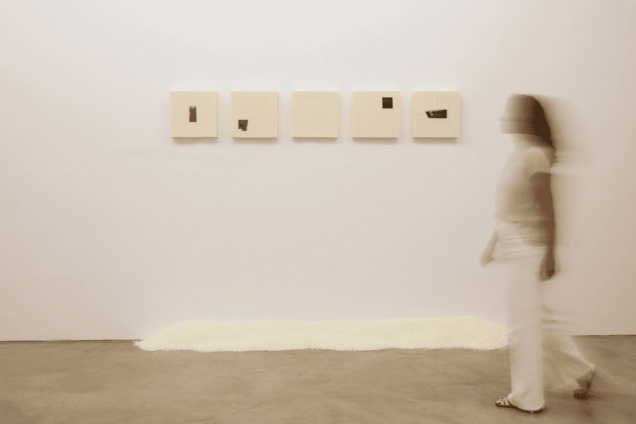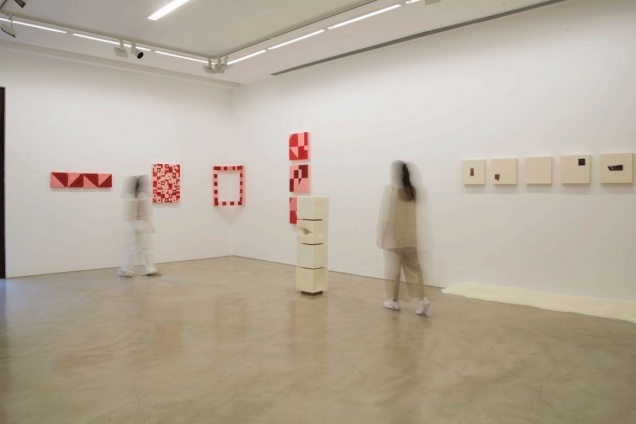WHEN IT CEASED TO BE
GELLI SISTERS
From Sep 14 to Oct 27 2023
WHAT SONG WILL SING ABOUT THE UNDEFINABLE?
What song will sing about the undefinable?
Touch without touching, looking without seeing
The soul, the love, intertwined the indescribable
(Hilda Hilst, Wish, 2001)
The exhibit "When it Ceased to Be", by the Gelli Sisters, consisted of artwork on walls, sculptures, video art and performance. The works shown articulate with elements from the Brazilian concrete and neo-concrete art within its most formal, conceptual issues, or even in the importance of the relational measure between work and spectators, combining characteristic aspects of contemporary art in a unique way. The sensitive geometry developed by the artists was present in each of the pieces in the exhibit, as a result of a process of deep creative dialogue.
At the gallery's entrance a pile of small cubes that could be picked up by the public, offering a truly palpable experience for visitors. As we go through the exhibition with the tiny cube in our hands, feeling the shape, texture and temperature of the material used to build the works of art, the experience of seeing these works changes in such a way that sight is no longer the only sense that the work by the Gelli Sisters invokes in each of us.
Therefore, the cube worked as a sort of proof of what's real in the experience of the visit, and at the end, the public was allowed to put together a collective composition as part of this work's proposition.
The exhibit addressed, among other concepts, the combination of dualities. In this movement, present in the works, there is something that exceeds, that differs from a contrast, since we do not perceive the elements that can be pointed out as ambivalent or excluding among each other. On the contrary, we can observe the coexistences and passages that take place from the process of executing the work, the material that is used in its solid and liquid state, until it achieves the particular geometrical compositions created by the artists.
These works were molded with structures and creative tools thoroughly developed by the artists, in a plural production where both assemble the concept, shape, color, and space in each stage, combining repetitions and detours along the path.
The technique used by Alice and Gabi Gelli seeks successively to underline, either in the tireless process of making the pieces or in what is presented as the final work, the importance of what is before us, of what we see as matter transformed and handled in making (in pairs, in dialogue).
This way, it is especially through the combined presence - our own and that of the works - that something important happens: this is where we can symbolically incorporate what the artists present.
The space of our encounter in the poetics of the Gelli Sisters is insurmountable, a place where we question and undo something about the growing global tendency toward the virtuality of relationships, both in the realm of art and life.
This issue was developed with subtle intelligence and precision by the sisters in the performance Encontro Presencial/Physical Meeting where the cube gains a new meaning, exchanging the relationship of affable containment of the hands for another, which converses with the architecture and becomes a barrier.
Placed in between the two artists, the cube was pierced not only by the fire that melted it but also by the desire to breach, to cross, to produce an encounter, contact affection.
Caetano Veloso, in the song 'if you hold a stone' tell us: if you hold the stone, hold it in your hand if you feel the weight, you'll soon understand - in an apparent allusion to the "proof of what's real" - a small stone that Lygia Clark gave the participants of settings she created with her relational objects.
Part of the lesson that this ensemble of works presented in When is Ceased to Be offers the public, is what we do together with what we see and experience. The cube may exist as the "stone" to be held , turning it into a relational object, allowing us a tactile approach of the constructive compositions we saw in the exhibit, but it can also be the barrier that will be broken down by our presence and presence of others.
In all works, there are invisible layers to the eyes, but which are perceptible to our sensations. Each stage that no longer is, also allows us to see what remains, even if by an undefinable, resonant absence.
The stanza from the poem by Hilda Hilst in the heading, an inspiration for the title of this curatorial text, also teaches us to sing the undefinable, touch with the eyes, and intertwine the indescribable.
A possible music score, dear readers/spectators, for our plunge into the visual and sensitive dialectic that the Gelli Sisters present us with.
Daniela Mattos

 Exhibition view
Exhibition view
 Exhibition view
Exhibition view
 Exhibition view
Exhibition view
 Exhibition view
Exhibition view
 Exhibition view
Exhibition view
 Exhibition view
Exhibition view